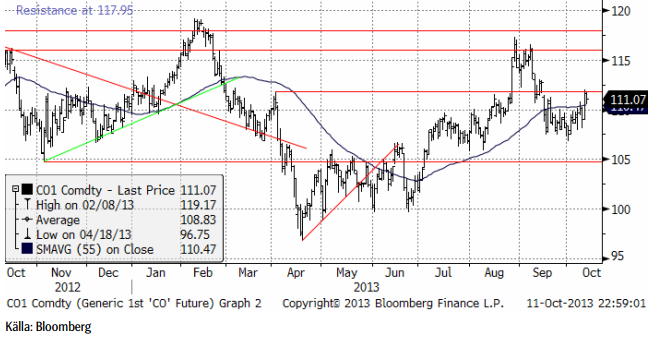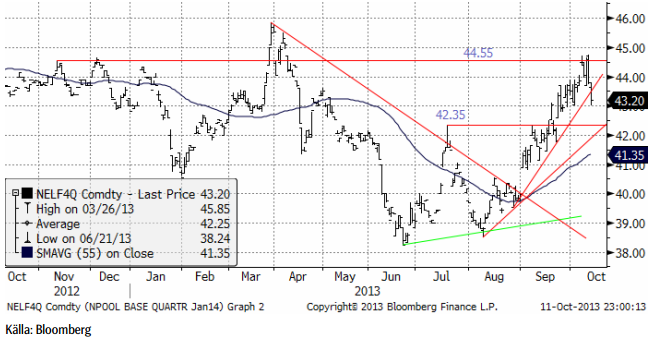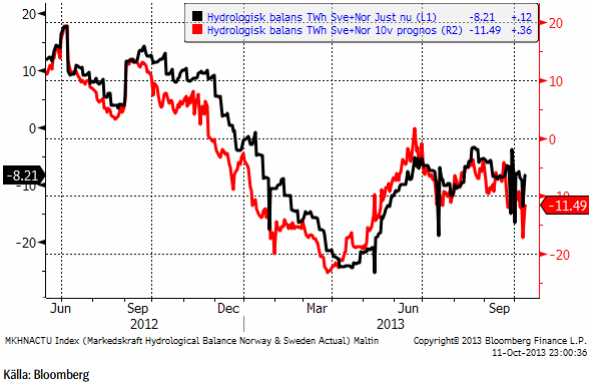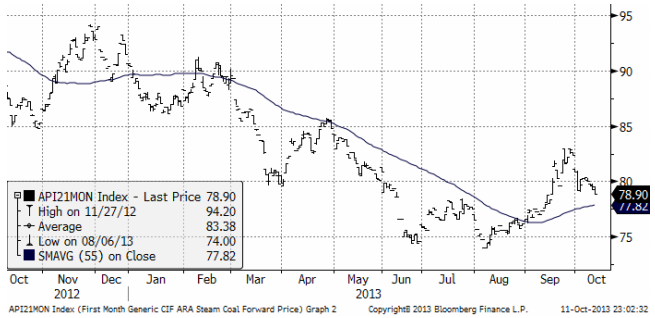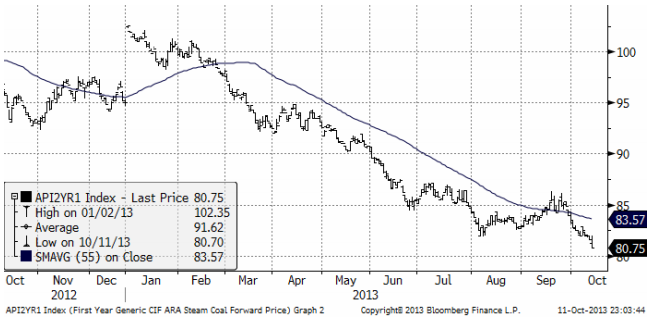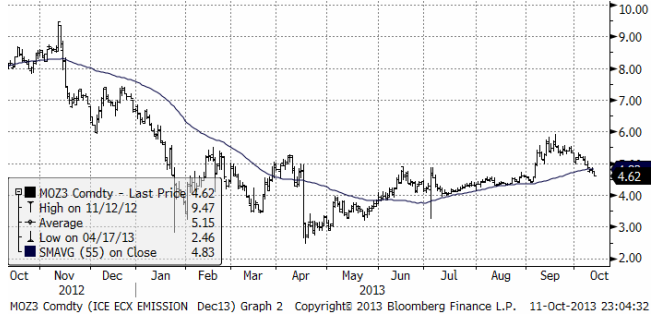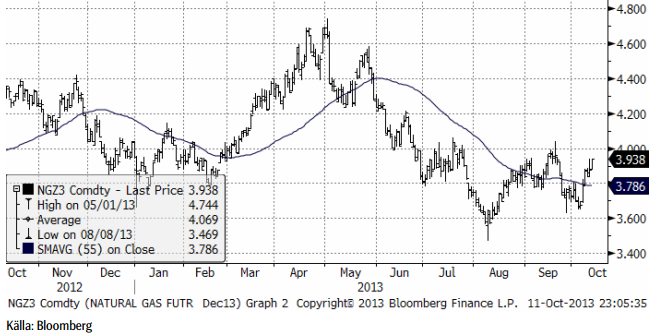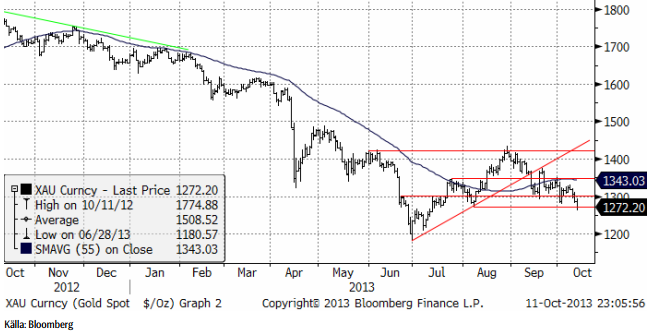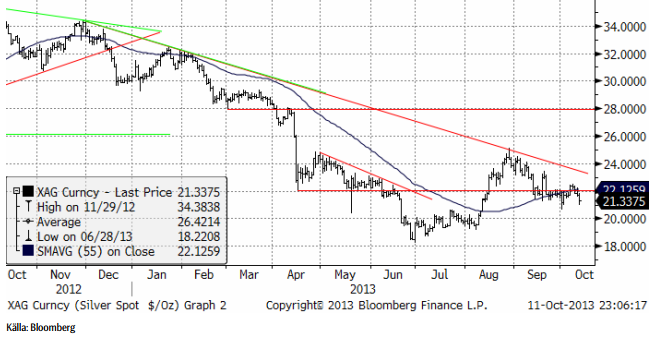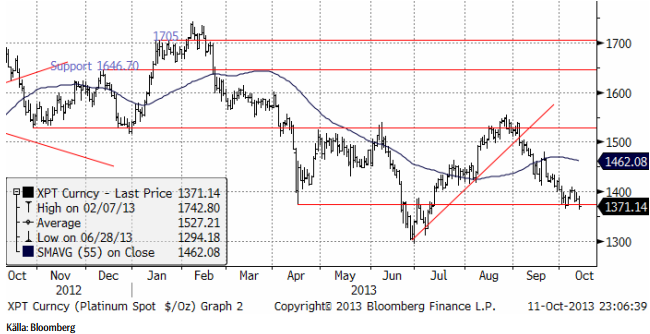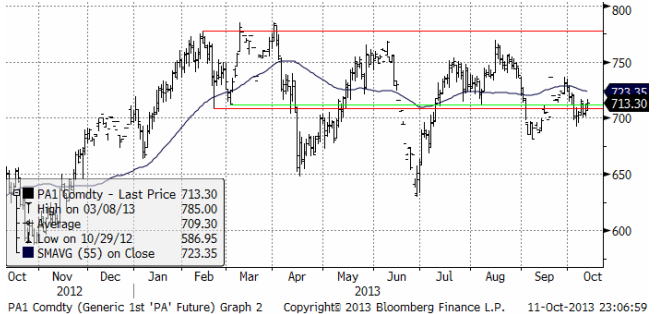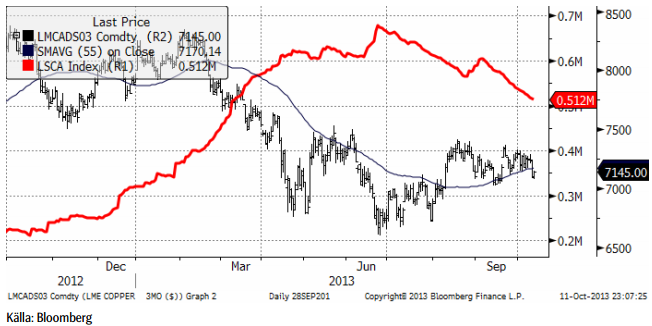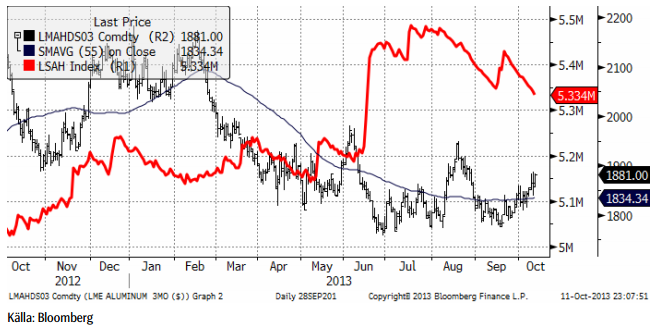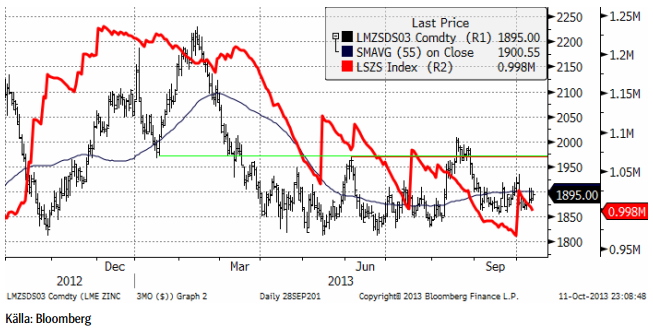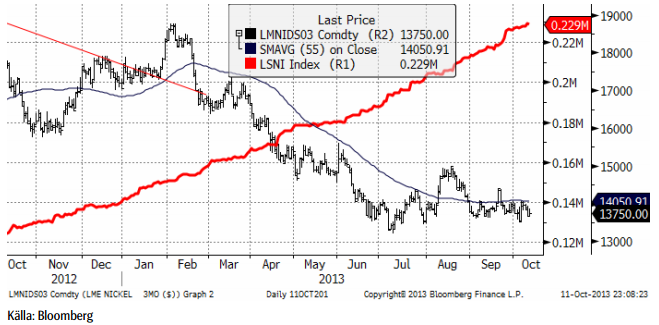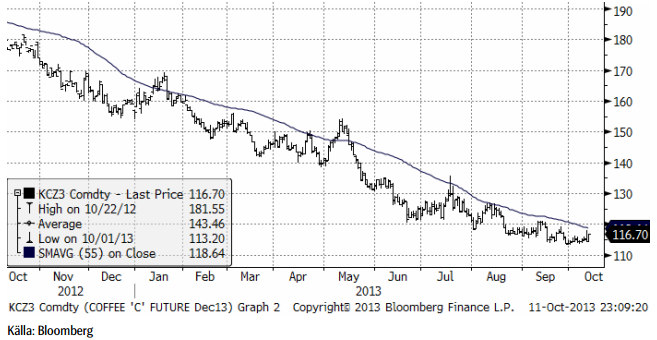Analys
SEB – Råvarukommentarer, 14 oktober 2013
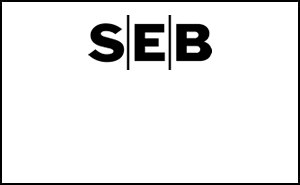
Rekommendationer
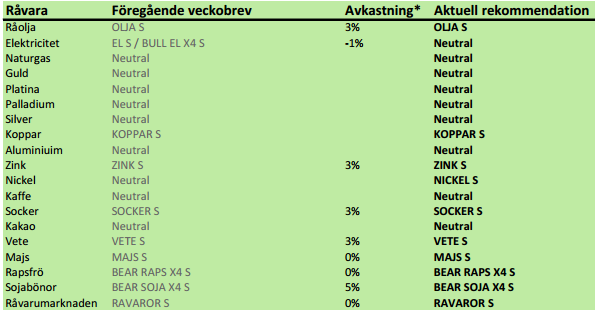 *) Avkastningen anges för 1:1 certifikaten där både BULL och 1:1 certifikat är angivna.
*) Avkastningen anges för 1:1 certifikaten där både BULL och 1:1 certifikat är angivna.
Inledning
Vi går över till neutral rekommendation på EL S och BULL EL X4 S. Anledningen är att elpriset stigit i veckan, medan kostnadsfaktorerna bakom: kolpris och utsläppsrätter fallit i pris. Vi tror att det finns potential för elpriset att backa och att man bör vänta ut den rekylen för att köpa igen – beroende på hur kol- och utsläppsrättsmarknaderna också utvecklar sig.
Guld och andra ädelmetaller har utvecklat sig svagt och testar just nu tekniska stöd. Om de bryts kan priserna falla ytterligare.
Många marknader som gått starkt och där vi haft rätt i våra rekommendationer som baserar sig på en allmän, men osynkroniserad återhämtning i råvarumarknaderna, ser att stå inför en rekyl nedåt. Det är ett helt naturligt marknadsbeteende och förändrar inte vår positiva grundsyn. Den allmänna rekommendationen blir då att vänta ut rekylen och försöka komma in i marknaden till bättre pris.
Råolja – Brent
Oljepriset steg med 1% förra veckan och OLJA S-certifikatet steg med 3%, delvis pga rabatten på terminerna, men till största delen på grund av att dollarn steg mot svenska kronor. Oljepriset slog i motståndet vid 112 dollar och stängde i fredags i 111 dollar per fat.
Amerikanska DOE publicerar ingen statistik, eftersom den delen av statsförvaltningen är stängd.
Frankrike har återigen fastställt förre presidenten Sarkozys förbud mot prospektering av skiffergas och skifferolja. Frankrike anses vara det land i Europa som har störst sådana resurser. I Brasilien, på land strax innanför semesterparadiset Natal har vad som förefaller vara en större oljefyndighet påträffats. Mexikos regering har fattat beslut att i grunden förbättra förutsättningarna för det nationella oljebolaget PEMEX. PEMEX har varit en sorglig historia, det mest plundrade oljebolaget bland plundrade oljebolag i världen. De har inte ens fått behålla nog med pengar i bolaget för att täta oljeläckor som är vida överstiger de från Deepwater Horizon i Mexikanska golfen. Än mindre syssla med normalt underhåll och naturligtvis inte utveckla ny produktion. Mexiko är ett mycket oljerikt land. Om Mexiko verkligen börjar driva PEMEX effektivt kan produktionen öka väsentligt med påverkan på oljepriset. Statlig produktionsbeskattning som kostnadsdrivare i oljepriset förklaras av Marian Radetzki i artikeln ”Politiska förvecklingar – inte OPEC:s marknadskontroll – förklarar oljeprisets fenomenala utveckling” i Ekonomisk Debatt nummer 2 / 2013.
En lägre internationell handel med är en direkt konsekvens av att USA:s inhemska produktion är på väg mot en ny rekordproduktion med minskat importbehov som följd. USA lär ha svårt att exportera olja, pga den 100 år gamla ”Jones Act”, som dikterar att sådan export måste ske på fartyg byggda i USA, registrerade och ägda av en amerikan och ha amerikansk besättning och kapten. Idag finns knappast någon sådan oljetanker.
SEB tror att priset rör sig ner mot 105 dollar mot slutet av året. På kort sikt är det intressant att se om priset bryter igenom motståndet på 112 dollar.
På grund av den attraktiva rabatten på terminer i oljemarknaden och för att vi inte ser någon omedelbar risk för väsentligt lägre pris på olja rekommenderar vi innehav i OLJA S.
Elektricitet
Elpriset backade rejält i fredags. Priset nådde i veckan upp till 44.60 euro per MWh, men orkade inte genom det motstånd som väntade där på 44.55.
Markedskrafts prognos för hydrologisk balans, har fallit till -11.49 TWh för 10-veckorsprognosen.
Kontraktet för den närmaste månadens leverans av energikol har backat.
Årskontraktet på energikol har dock fallit till en ny bottennotering på 80.75 dollar per ton.
Priset på utsläppsrätter har också backat.
Vi har en långsiktigt positiv vy på elpriset baserat på en normalisering av marknaden för kol – drivet dels av begränsad produktionstillväxt pga det för låga priset och för att efterfrågan tar fart på grund av en konjunkturuppgång. Elpriset har den senaste tiden gått upp kraftigt på Nasdaq, men de faktorer vi baserar vår prognos på, har gått ner i pris.
Vi rekommenderar att man tar hem vinster i EL S och BULL EL X4 S och vi rekommenderar neutral position. Kommer priset på kvartalskontraktet ner till 42 till 42.50 euro kan man kanske köpa igen, om en botten där tycks etablera sig. Faktorerna bakom det långsiktiga ”caset” tror vi fortfarande på, men veckans prisnedgång i dessa: kol och utsläppsrätter – motiverar även en nedgång i elpriset, som vi inte har sett fullt ut än. Vi vill understryka att den här rekommendationen om vinsthemtagning och neutral position handlar om ”timing” och inte om det långsiktiga ”investerings-caset”.
Naturgas
Naturgasprisets rekyl nedåt i slutet av september stängde på en högre nivå än nedgången i augusti, vilket är ett styrketecken. 4 dollar per MMBtu är dock ett motstånd på ovansidan.
Vi har neutral rekommendation.
Guld & Silver
Guldpriset föll med 3% i veckan och stängde precis på ett det sista tekniska stödet på nedsidan innan priset faller till 1200 dollar. Tekniskt ser det ut som om marknaden kommer att handla ner till 1200 dollar igen och det finns inga garantier för att priset på guld inte går ännu lägre. Andra råvarumarknader som haft ett överkott i produktionen sedan årsskiftet 2010/2011, när konjunkturen vände ner och produktionen av råvaror kom ikapp efterfrågetakten, har vänt upp när nu konjunkturen vänt uppåt igen och de låga priserna fått producenter att dra ner. Detta har inte hänt i guldmarknaden. Guldproducenter har alltid förefallit mer övertygade om just deras råvaras förestående hausse än andra råvaruproducenter har gjort. Jag känner inte till någon guldproducent som kastat in handduken på grund av kostnader, om vi bortser från bristfälligt finansierade prospekteringsbolag. De flesta tolkar en förestående lösning på budgetkrisen i USA som negativt för guldet, dvs som en minskad takt i skuldökningen i USA; en förlust för den sittande presidenten. Detta har påverkat guldmarknaden negativt. Medan Kinas inflation, enligt Kinas statistiska centralbyrå, är 2.6%, är verkligheten av råvaruprisboomen där förmodligen betydligt högre, men Kinas guldköp dominerar inte över USA:s. Kinas ekonomi är än så länge ungefär lika kraftfull som Italiens. Italienarna är i och för sig oroliga för en skatt på sparande. IMF kom i veckan ut med en rapport som föreslår en skatt på 10% av eurozonens medborgares sparande som en metod att lösa skuldkrisen. Det är en metod som Italien använde sig av för att lösa skuldkrisen efter valutakrisen i början av 1990-talet. Det naturliga för de flesta är dock att ta ut pengarna från bankkontot, inte att köpa guld.
Guldpriset har inte ändrat trend än. Och det troliga är att nedgången fortsätter.
Nedan ser vi kursdiagrammet för silver i dollar per troy ounce. Det ser ut som om 20 dollar ska testas igen.
Vi fortsätter att vara neutrala guld och silver och skulle inte vilja köpa någon av dem idag.
Platina & Palladium
Platinapriset stängde i fredags på ett teniskt stöd. Det har varit en solid nedgång sedan månadsskiftet augusti-september och det marknaden är i behov av en uppgång, men om guldmarknaden faller igenom sitt stöd, bör även platina fall ner mot 1300 dollar. Priset står just nu och väger. Jag tror mer på en nedgång. Om priset går över 1400 dollar har vi däremot en köpsignal, enligt teknisk analys.
Nedan ser vi frontmånadskontraktet på palladium. Palladium ligger fortfarande i en slags sidledes rörelse, utan trend.
Vi är för närvarande neutrala platina och palladium, men om palladium skulle falla bara något lite, skulle vi vilja haka på och ta en kort position via BEAR PALLAD X4 S. Vi skulle absolut inte vilja köpa någon av dem.
Koppar
Den årliga höjdpunkten för metallbranschen, ”LME Week” inföll förra veckan. Huvudtalaren på LME-veckans seminarium sammanfattade sin syn på metallmarknaden med uttalandet : ”en fast golv och ett mjukt tak” De flesta som samlades i London för den traditionella LME – veckan höll nog med om det, åtminstone vad gäller golvet. Diskussionerna på de olika konferenserna och mötena handlade mest om mjukheten i taket. De flesta metallmarknader präglas av ett överutbud, men i olika faser. Vissa marknaders överutbud ökar och andra minskar.
Den nye VD:n för LME talade om ökad öppenhet, utan att ge några konkreta exempel på vad det kan innebära. Han nämnde att den nye kinesiska börsen HEX ägande kan innebära några nya produkter, t ex på järnmalm och kol.
I veckan annonserade CME att man introducerar ett aluminiumkontrakt som ska ha månadsvisa terminer. LME har som bekant dagliga, dvs det finns alltid ett kontrakt som går i leverans varje dag. CME äger via sitt dotterbolag NYMEX (COMEX), redan en börs för aluminium, som är futures. Den har dock aldrig varit särskilt populär i jämförelse med LME:s kontrakt. Bakgrunden till att CME startar handel i en kopia av LME:s kontrakt är den kritik som riktats mot köbildningen vid LME:s lagerhus, som gjort att marknaden för fysisk metall avviker prismässigt väldigt mycket från LME:s kontrakt. CME skulle använda sina egna lagerhus i USA, enligt den pressrelease som publicerades i veckan. LME:s flytt till Kina, sannolikt motiverad till inte liten del av EU:s nya lagförslag MiFID 2, som allvarligt kommer att förstöra möjligheterna att handla terminer på råvaror inom EU, öppnar för ny konkurrens från CME i västvärlden.
Handeln på börsen var av naturliga skäl tunn, i veckan som gick. Svaghet var tydlig i början av veckan, och i synnerhet koppar handlades ner, av allt att döma pga en stor säljorder. Mot slutet av veckan kom köparna in och handlade upp marknaderna igen. Koppar och nickel avslutade veckan 1 – 2% lägre, medan aluminium och zink stängde veckan upp i samma storleksordning. Lagren vid LME fortsatte att minska i veckan som gick och vi tror att kopparpriset kommer att testa motstånden på ovansidan från i somras.
Codelco publicerade premien för katoder för nästa år under helgen till förra veckan. Den hamnade på 112 dollar per ton, en höjning från årets 85 dollar. Det är ett tecken på den mindre smältverkskapaciteten, som orsakas av underhållsarbeten och nedläggningar.
Efterfrågan är god. Det har sagts att kopparmarknaden skulle behöva 1 mt / år mer produktionskapacitet per år för att hålla jämna steg med den långsiktiga efterfrågeökningen. Det låga priset nu är lite för lågt för att stimulera den här produktionsökningen.
Vi rekommenderar köp av KOPPAR S.
Aluminium
Folk gick till LME-veckan med en baissig inställning till aluminium, men åkte nog hem något mindre negativa. I mitten av förra veckan visade en del analytiker ett mindre överskott (produktion > konsumtion) än tidigare och Alcoa publicerade sin kvartalsrapport i onsdags – som skrev om ett kommande underskott! Även om folk anser detta som tämligen osannolikt, räckte bränslet för en prisuppgång. Efter uppgången mot 1890 i fredags börjar marknaden se lite dyr ut istället. Det finns trots allt ett överskott och Kina investerar just nu i ny kapacitet istället för att dra ner. Alcoa behöll sin prognos på en stadig efterfrågeökning om 7% per år, vilket är i linje med, men något högt, jämfört med de flesta analytikers prognoser. Så länge utbudet ökar mindre än efterfrågan kommer det att ske en långsam, men stadig förbättring av den grundläggande balansen, men fortfarande finns det stora lager som måste betas av.
Vi har neutral rekommendation, men lutar mot en köprekommendation.
Zink
Zink har till viss del en liknande situation som aluminium, där Kina är mer eller mindre självförsörjande, med massor av smältverkskapacitet. De långsiktigt positiva utsikterna för zink beror på gruvsektorn och nedläggningar under de kommande åren. Just nu finns det tillräckligt med material, men som vi har noterat går marknaden mot ett underskott. Detta kommer delvis även att komma från stigande efterfrågan. Bilförsäljningen i Kina ökade med 21% i augusti till 1,59 miljoner. Bilindustrin är den viktigaste sektorn för zink. 50-60% av zinkkonsumtionen går till galvaniserat stål, och av detta används ca hälften som rostskyddat stål i bilar.
Tekniskt ser marknaden ut att ha etablerat en botten vid 1800 – 1850 dollar per ton. Samtidigt finns motstånd vid 1950 – 2000 dollar. Vi tror att dessa nivåer kommer att testas och slutligen brytas.
Vi fortsätter med en köprekommendation av ZINK S.
Nickel
Nickelpriset stängde veckan med ett litet plus, men tekniskt ser det ut som om det skulle kunna komma en vända ner till, innan priserna vänder upp.
Samtalen i London under LME-veckan var fokuserade på sannolikheten för ett indonesiskt exportförbud från januari 2014. Realpolitik indikerar dock att det inte kommer att bli ett förbud, därför att landet behöver exportintäkterna. De senaste två veckorna har ett par gruvor lagts ner: Falcondo i Dominikanska Republiken med 15,000 ton årlig produktion av ferronickel och Votoantims gruva i Brasilien med 19,000 ton årlig produktion av nickel. När det gäller Kinas produktion av nickeltackjärn (NPI) menade personer på LME-veckan vi talat med att kostnaden snarare är på väg ner, än upp. Fokus fram till nyår kommer att ligga på hur Indonesien gör med sitt exportförbud.
Kaffe
Kaffepriset noterade nya, fräscha, bottennoteringar i veckan som gick. Trenden är nedåtriktad. Vi väntar på en uppgång, men fortsätter att vänta av timing-skäl. På lite längre sikt borde kaffe vara en given vinnare.
Odlingsåret 2012/13 är nu avslutat i alla exportländer. International Coffee Organization skriver i sin senaste månadsrapport att total global produktion uppgår till 145.2 miljoner säckar (60 Kg). Detta är 12.8 miljoner säckar mer än 2011/12, en ökning med 9.6%. Robusta står för den största ökningen med 11.6% till 56.4 miljoner säckar, medan produktionsökningen av arabica var 8.4% till 88.8 miljoner säckar. Global produktion under 2012 (kalenderår) uppgår enligt ICO till 142 miljoner säckar och följer den ökningstakt om 2.4% som har registrerats de senaste fyra åren. Det råder alltså fortfarande en överproduktion i världen. Orsaken att de höga priserna får några år sedan ledde till ökad plantering av kaffebuskar. Det tar minst två år innan de
börjar ge skörd.
I Colombia, som sedan 2008/09 haft stora problem med bladmöglet ”roya”, har man ersatt odlingarna med nya sorter, som är resistenta mot bladmöglet. För två år sedan var produktionen nere i 7.7 miljoner säckar, men har skördat 9.93 miljoner säckar under 2012/13-säsongen, som slutade i september. Det är 1 miljon mer än USDA förutspått. Det är möjligt att Colombia kan nå 12 miljoner säckar under 2013/14, när de nya kaffebuskarna börjar bära frukt ordentligt för att nästa år kanske nå upp till 14
miljoner säckar.
I Vietnam, som väntat en rekordskörd av robusta har drabbats av skyfall, vilket fördröjer skörden.
Brasilianska Cepea säger att det är först under 2014 som regeringens interventionsköp kan börja visa sig i priserna.
Vi behåller tills vidare neutral rekommendation, tills vi ser tecken på ett trendbrott.
[box]SEB Veckobrev Veckans råvarukommentar är producerat av SEB Merchant Banking och publiceras i samarbete och med tillstånd på Råvarumarknaden.se[/box]
Disclaimer
The information in this document has been compiled by SEB Merchant Banking, a division within Skandinaviska Enskilda Banken AB (publ) (“SEB”).
Opinions contained in this report represent the bank’s present opinion only and are subject to change without notice. All information contained in this report has been compiled in good faith from sources believed to be reliable. However, no representation or warranty, expressed or implied, is made with respect to the completeness or accuracy of its contents and the information is not to be relied upon as authoritative. Anyone considering taking actions based upon the content of this document is urged to base his or her investment decisions upon such investigations as he or she deems necessary. This document is being provided as information only, and no specific actions are being solicited as a result of it; to the extent permitted by law, no liability whatsoever is accepted for any direct or consequential loss arising from use of this document or its contents.
About SEB
SEB is a public company incorporated in Stockholm, Sweden, with limited liability. It is a participant at major Nordic and other European Regulated Markets and Multilateral Trading Facilities (as well as some non-European equivalent markets) for trading in financial instruments, such as markets operated by NASDAQ OMX, NYSE Euronext, London Stock Exchange, Deutsche Börse, Swiss Exchanges, Turquoise and Chi-X. SEB is authorized and regulated by Finansinspektionen in Sweden; it is authorized and subject to limited regulation by the Financial Services Authority for the conduct of designated investment business in the UK, and is subject to the provisions of relevant regulators in all other jurisdictions where SEB conducts operations. SEB Merchant Banking. All rights reserved.
Analys
Tightening fundamentals – bullish inventories from DOE

The latest weekly report from the US DOE showed a substantial drawdown across key petroleum categories, adding more upside potential to the fundamental picture.

Commercial crude inventories (excl. SPR) fell by 5.8 million barrels, bringing total inventories down to 415.1 million barrels. Now sitting 11% below the five-year seasonal norm and placed in the lowest 2015-2022 range (see picture below).
Product inventories also tightened further last week. Gasoline inventories declined by 2.1 million barrels, with reductions seen in both finished gasoline and blending components. Current gasoline levels are about 3% below the five-year average for this time of year.
Among products, the most notable move came in diesel, where inventories dropped by almost 4.1 million barrels, deepening the deficit to around 20% below seasonal norms – continuing to underscore the persistent supply tightness in diesel markets.
The only area of inventory growth was in propane/propylene, which posted a significant 5.1-million-barrel build and now stands 9% above the five-year average.
Total commercial petroleum inventories (crude plus refined products) declined by 4.2 million barrels on the week, reinforcing the overall tightening of US crude and products.


Analys
Bombs to ”ceasefire” in hours – Brent below $70

A classic case of “buy the rumor, sell the news” played out in oil markets, as Brent crude has dropped sharply – down nearly USD 10 per barrel since yesterday evening – following Iran’s retaliatory strike on a U.S. air base in Qatar. The immediate reaction was: “That was it?” The strike followed a carefully calibrated, non-escalatory playbook, avoiding direct threats to energy infrastructure or disruption of shipping through the Strait of Hormuz – thus calming worst-case fears.

After Monday morning’s sharp spike to USD 81.4 per barrel, triggered by the U.S. bombing of Iranian nuclear facilities, oil prices drifted sideways in anticipation of a potential Iranian response. That response came with advance warning and caused limited physical damage. Early this morning, both the U.S. President and Iranian state media announced a ceasefire, effectively placing a lid on the immediate conflict risk – at least for now.
As a result, Brent crude has now fallen by a total of USD 12 from Monday’s peak, currently trading around USD 69 per barrel.
Looking beyond geopolitics, the market will now shift its focus to the upcoming OPEC+ meeting in early July. Saudi Arabia’s decision to increase output earlier this year – despite falling prices – has drawn renewed attention considering recent developments. Some suggest this was a response to U.S. pressure to offset potential Iranian supply losses.
However, consensus is that the move was driven more by internal OPEC+ dynamics. After years of curbing production to support prices, Riyadh had grown frustrated with quota-busting by several members (notably Kazakhstan). With Saudi Arabia cutting up to 2 million barrels per day – roughly 2% of global supply – returns were diminishing, and the risk of losing market share was rising. The production increase is widely seen as an effort to reassert leadership and restore discipline within the group.
That said, the FT recently stated that, the Saudis remain wary of past missteps. In 2018, Riyadh ramped up output at Trump’s request ahead of Iran sanctions, only to see prices collapse when the U.S. granted broad waivers – triggering oversupply. Officials have reportedly made it clear they don’t intend to repeat that mistake.
The recent visit by President Trump to Saudi Arabia, which included agreements on AI, defense, and nuclear cooperation, suggests a broader strategic alignment. This has fueled speculation about a quiet “pump-for-politics” deal behind recent production moves.
Looking ahead, oil prices have now retraced the entire rally sparked by the June 13 Israel–Iran escalation. This retreat provides more political and policy space for both the U.S. and Saudi Arabia. Specifically, it makes it easier for Riyadh to scale back its three recent production hikes of 411,000 barrels each, potentially returning to more moderate increases of 137,000 barrels for August and September.
In short: with no major loss of Iranian supply to the market, OPEC+ – led by Saudi Arabia – no longer needs to compensate for a disruption that hasn’t materialized, especially not to please the U.S. at the cost of its own market strategy. As the Saudis themselves have signaled, they are unlikely to repeat previous mistakes.
Conclusion: With Brent now in the high USD 60s, buying oil looks fundamentally justified. The geopolitical premium has deflated, but tensions between Israel and Iran remain unresolved – and the risk of missteps and renewed escalation still lingers. In fact, even this morning, reports have emerged of renewed missile fire despite the declared “truce.” The path forward may be calmer – but it is far from stable.
Analys
A muted price reaction. Market looks relaxed, but it is still on edge waiting for what Iran will do

Brent crossed the 80-line this morning but quickly fell back assigning limited probability for Iran choosing to close the Strait of Hormuz. Brent traded in a range of USD 70.56 – 79.04/b last week as the market fluctuated between ”Iran wants a deal” and ”US is about to attack Iran”. At the end of the week though, Donald Trump managed to convince markets (and probably also Iran) that he would make a decision within two weeks. I.e. no imminent attack. Previously when when he has talked about ”making a decision within two weeks” he has often ended up doing nothing in the end. The oil market relaxed as a result and the week ended at USD 77.01/b which is just USD 6/b above the year to date average of USD 71/b.

Brent jumped to USD 81.4/b this morning, the highest since mid-January, but then quickly fell back to a current price of USD 78.2/b which is only up 1.5% versus the close on Friday. As such the market is pricing a fairly low probability that Iran will actually close the Strait of Hormuz. Probably because it will hurt Iranian oil exports as well as the global oil market.
It was however all smoke and mirrors. Deception. The US attacked Iran on Saturday. The attack involved 125 warplanes, submarines and surface warships and 14 bunker buster bombs were dropped on Iranian nuclear sites including Fordow, Natanz and Isfahan. In response the Iranian Parliament voted in support of closing the Strait of Hormuz where some 17 mb of crude and products is transported to the global market every day plus significant volumes of LNG. This is however merely an advise to the Supreme leader Ayatollah Ali Khamenei and the Supreme National Security Council which sits with the final and actual decision.
No supply of oil is lost yet. It is about the risk of Iran closing the Strait of Hormuz or not. So far not a single drop of oil supply has been lost to the global market. The price at the moment is all about the assessed risk of loss of supply. Will Iran choose to choke of the Strait of Hormuz or not? That is the big question. It would be painful for US consumers, for Donald Trump’s voter base, for the global economy but also for Iran and its population which relies on oil exports and income from selling oil out of that Strait as well. As such it is not a no-brainer choice for Iran to close the Strait for oil exports. And looking at the il price this morning it is clear that the oil market doesn’t assign a very high probability of it happening. It is however probably well within the capability of Iran to close the Strait off with rockets, mines, air-drones and possibly sea-drones. Just look at how Ukraine has been able to control and damage the Russian Black Sea fleet.
What to do about the highly enriched uranium which has gone missing? While the US and Israel can celebrate their destruction of Iranian nuclear facilities they are also scratching their heads over what to do with the lost Iranian nuclear material. Iran had 408 kg of highly enriched uranium (IAEA). Almost weapons grade. Enough for some 10 nuclear warheads. It seems to have been transported out of Fordow before the attack this weekend.
The market is still on edge. USD 80-something/b seems sensible while we wait. The oil market reaction to this weekend’s events is very muted so far. The market is still on edge awaiting what Iran will do. Because Iran will do something. But what and when? An oil price of 80-something seems like a sensible level until something do happen.
-

 Nyheter3 veckor sedan
Nyheter3 veckor sedanMahvie Minerals växlar spår – satsar fullt ut på guld
-

 Nyheter4 veckor sedan
Nyheter4 veckor sedanUppgången i oljepriset planade ut under helgen
-

 Nyheter4 veckor sedan
Nyheter4 veckor sedanLåga elpriser i sommar – men mellersta Sverige får en ökning
-

 Nyheter3 veckor sedan
Nyheter3 veckor sedanJonas Lindvall är tillbaka med ett nytt oljebolag, Perthro, som ska börsnoteras
-

 Analys3 veckor sedan
Analys3 veckor sedanA muted price reaction. Market looks relaxed, but it is still on edge waiting for what Iran will do
-

 Nyheter3 veckor sedan
Nyheter3 veckor sedanOljan, guldet och marknadens oroande tystnad
-

 Analys4 veckor sedan
Analys4 veckor sedanVery relaxed at USD 75/b. Risk barometer will likely fluctuate to higher levels with Brent into the 80ies or higher coming 2-3 weeks
-

 Nyheter3 veckor sedan
Nyheter3 veckor sedanDomstolen ger klartecken till Lappland Guldprospektering


